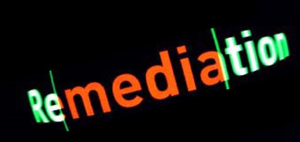Transparency: The concept of media being hidden from the viewer, so that she is  focused on the content exclusively, paying attention to the “THROUGH” and ignoring completely the “AT.” Transparency is closely linked with immediacy.
focused on the content exclusively, paying attention to the “THROUGH” and ignoring completely the “AT.” Transparency is closely linked with immediacy.
Immediacy: The feeling of being “IN” the media and experiencing what is happening. If immediacy is immersive enough (often by drawing on the audience’s emotions or otherwise engaging the viewer), the medium has succeeded in being transparent. Some Reality TV shows or “front lines” reporting, along with video games or virtual reality games, often seek immediacy. When a viewer is engaged (as is the case when playing Call of Duty), he forgets that he is playing a game because he is in the middle of the fighting. Only when his avatar is hurt or killed, or when his mother calls him to dinner, does the viewer remember that the feeling of immediacy is a fabrication. Although a video or virtual reality game may be pixelated, when the viewer is drawn in through immediacy, the medium may become transparent to him.
Hypermediacy: bringing the various media “front and center,” even glorying in the numerous styles that all appear in one framework. A news web page illustrates this concept because it has various images all vying for attention from the audience along with hyperlinks, frames of text, frames of video, advertisements, “Breaking News” video feeds, widgets like the weather and stock reports, and search boxes.
Remediation: the concept of “refashioning” or “repurposing” (from Sandra Beaudin) an  older form of content into a newer form. Sometimes a newer medium will try to make a complete break from an older form, but generally, no one medium can stand alone in isolation; remediation usually “absorbs” the older medium (47), like emails have refashioned the hand-written letter or e-books have repurposed the print book. Television news broadcasts are remediated into news web pages, showing up as little boxes of “Live TV.” Next to the little TV boxes, other news stories are listed similar to the double column format of a print newspaper. Advertisements from both television and newspapers are remediated into the news web site; some are static like those from newspapers while others offer video clips similar to the advertisements from television. The ubiquity of the internet allows advertisers to take their message one step further by making their advertisements interactive; with just the click of a mouse (or on some screens, the tap of a finger), the viewer can easily find the advertiser’s services and/or products and even place an order.
older form of content into a newer form. Sometimes a newer medium will try to make a complete break from an older form, but generally, no one medium can stand alone in isolation; remediation usually “absorbs” the older medium (47), like emails have refashioned the hand-written letter or e-books have repurposed the print book. Television news broadcasts are remediated into news web pages, showing up as little boxes of “Live TV.” Next to the little TV boxes, other news stories are listed similar to the double column format of a print newspaper. Advertisements from both television and newspapers are remediated into the news web site; some are static like those from newspapers while others offer video clips similar to the advertisements from television. The ubiquity of the internet allows advertisers to take their message one step further by making their advertisements interactive; with just the click of a mouse (or on some screens, the tap of a finger), the viewer can easily find the advertiser’s services and/or products and even place an order.
Old Media / New Media: Depending on how far back one goes, “old media” can be anything from clay-mation movies (think Rudolph the Red-Nosed Reindeer from 1964) to Egyptian cave drawings (think King Tut’s tomb circa 1300 B.C.E.). An older form of communication or visual depiction is considered “old media” and whatever replaces it is considered “new media,” which perpetuates a cycle. The hand puppet (old media) may have been replaced by a stop-motion video (new media for its time) which was replaced by drawn cartoons (new media making the stop-motion old media) which was then replace by CGI (new media making the cartoon old media).
1 Comment
The definitions you two posted for your key concepts are very clear and enlightening. I have had trouble conceptualizing remediation, immediacy, and transparency in the past, but I feel like I am on firmer ground now. I do have a question about video games and immediacy. As a gamer, I never forget that I am playing a game since the controller/keypad and the distance away from the screen are obstacles to true immersion, but I can see how having my attention fully absorbed by the game could be seen as a way of having forgotten the physical world around me.